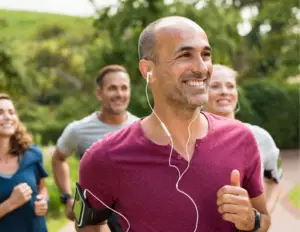
Rarefied Air: How to Meet Physical Activity Guidelines and Join the Elite 23%
I come from a competitive family. When we’re together, we meet physical activity guidelines like we suffer injuries – by accident. Backyard football games end

I love sports. My first word was “ball.” I started tee-ball at age 4. And my love for baseball grew the more I played. My younger brother and I played on the same rec league baseball teams that our dad coached.
And we won. A lot.
We put in work for those participation trophies. One year, our assistant coach bought us bigger trophies because (according to him) we deserved nicer hardware than the participation medals everyone got. So yeah, my 3rd grade baseball team had serious swag. Those were the glory days.

When I wasn’t at baseball practice or games, I collected baseball cards and played sports in the yard with my younger brother. On warm summer nights we had family baseball games in the backyard. We played with a tennis ball to protect the pitcher and the house.
Sadly, it ended after I ripped a line-drive through the living room window (sorry Mom) and bombed one too many home-runs onto the neighbor’s back porch (sorry Ms. Harris!).
Baseball came first, but I loved other sports too. I enjoyed soccer and basketball and played a bit of golf.

I started travel baseball in 5th grade. This meant lots of games and practices. Looking back, I’m not sure how my parents did it. They drove me all over Ohio and spent so many hours on the bleachers. I don’t have any kids yet; maybe I’ll understand one day.
I wasn’t a superstar on the 5th grade travel team, but I played a lot. At first I pitched, batted second and played third base. But arm problems soon stymied my pitching aspirations. I stayed at third base and tried to ignore the dull elbow pain I felt with every throw.
My arm felt better with rest, but the gnawing pain always returned after a couple throws. It kept hurting for a few months, so I went to the doctor, who sent me to physical therapy.
I completed my catalog of PT exercises dutifully. One PT assignment involved rubbing ice directly on my elbow until it went numb.
Besides the ice cup, I did a dozen daily exercises to strengthen my shoulder and upper back muscles. And plenty of core exercises. My 10-year-old brother was skeptical that ab exercises would help my elbow.
And they didn’t.
In retrospect, strengthening my shoulder wasn’t a terrible approach. But I don’t think my PT figured out why my elbow hurt when I threw a baseball.
Strike one for PT.
Eight weeks of PT, ice and home exercise got me nowhere, except sent back to the Sports Medicine physician. The doctor told me to take a few months off baseball to see if my elbow pain would abate.
Did I cry at this point? It’s not on video, so there’s no way to know for sure.
I couldn’t throw or hit, but the doctor said nothing about running. I talked with my coaches and they agreed to use me as a pinch runner.
One thing you should know about 12-year-old Jacob: he was a remarkably average baserunner. So my opportunities were limited. I cheered hard for my slow teammates to get on base. When they did, I got to pinch-run!
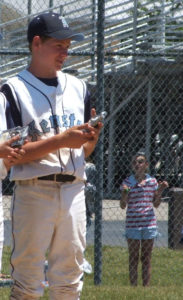
I even tried to throw left-handed. Let me tell you, it was ugly! I’m not a southpaw, and no amount of practice would make me one.
As I waited out my two-month sentence baseball ban, the doctor sent me to a psychologist with a glass eye to find out if the pain was all in my head. I sat in his plush office recliner and learned a purported “self-hypnosis” technique to help my elbow pain.
Thankfully it wasn’t too bizarre, just a basic relaxation technique. It helped me fall asleep a little easier at night, but my elbow pain stayed. Turns out it wasn’t all psychological.
A few months later I returned to the Sports Medicine doctor. She chalked up the elbow pain to “growing pains” and gave me the green light to return to baseball.

I was thrilled to be back on the baseball diamond, but the nagging arm pain did not recede. My frustration grew and my passion for baseball cooled. But my journey with another sport was just beginning.
During my failed elbow rehab, I figured out that hitting a golf ball didn’t hurt my arm. My grandfather taught me golf as a little kid, so I could hit the ball okay. The hand-eye coordination from baseball helped, too.
Turns out hitting a stationary ball is easier than making contact with a moving one. I was hooked. After 7th grade, I spent my summers at the golf course.
I golfed in high school, starting in autumn of freshman year. I shocked everyone (myself included) by shooting a 75 in the first round of tryouts. I’d barely broken 80 before, but I managed to beat the seniors and earn the #1 golf bag after 4 days of tryouts.
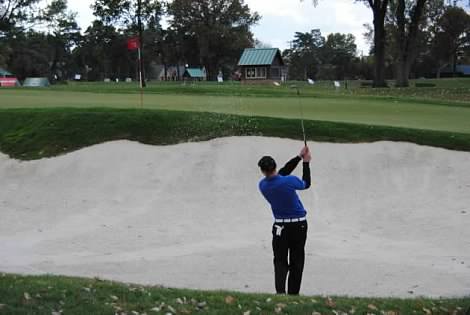
After exceeding expectations on the golf course, I decided to play freshman basketball. Apparently the law of averages caught up to me; I sat the bench as we lost all but 2 games.
But we practiced hard! The ratio of sprints to shooting drills was 12 to 1. My coach made sure we didn’t tire out in the 4th quarter. We didn’t. We didn’t make shots either. I learned a lot from the experience, mostly that I didn’t want to play basketball anymore.
Spring of 9th grade brought JV baseball. Fresh-cut grass, sunshine, and blue skies. But also elbow pain. It lingered in the background all season.

My elbow limited pitching opportunities, and I felt pain almost every throw from shortstop to first base. My coach and teammates were great, but I was exasperated with the elbow pain. So I quit baseball after 9th grade.
Because I stopped playing baseball and basketball, I needed to stay busy when the fairways were frozen during the long Ohio winters. For me, that meant sweating through P90X workouts with the golf team (and coach) in the physics classroom. You’ll never see a more intense study hall!
I appreciated the benefits of working out. Like getting stronger, sleeping better and feeling accomplished after a tough session. Exercise has been a key habit for me since the days of P90X with the golf guys.
After 4 fun, memorable years of high school golf, I got to play at an NCAA DII college. I’d dealt with occasional low back pain throughout high school. This continued into college. Standing, walking and golfing always felt great. Sitting in class was unpleasant (generally unpleasant, but especially so for my back).
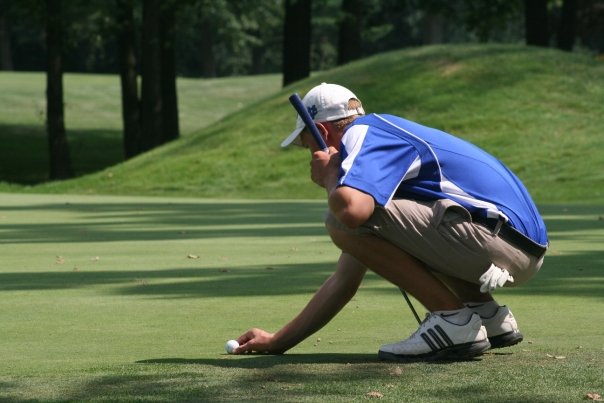
I saw multiple doctors. Some said it was just tight back muscles. Others told me it was my discs. The X-Rays didn’t show any problems. I didn’t know what to believe or what to do.
I tried physical therapy again, this time with a physical therapist I knew from church. He told me the pain was disc-related, and had me try repeated back extension stretches, which seemed to help. Unfortunately, I didn’t do the exercises as frequently as instructed. And I soon left town to return to college.
Though PT helped a bit, it didn’t resolve my back pain. I should have done those exercises more, so I’ll take responsibility for the suboptimal outcome.
Strike two for PT.
I trained hard for college golf. Between lifting, running, and carrying my golf bag 5-6 miles over 18 holes, it was physically demanding. My back pain never affected golf.
Until it did.
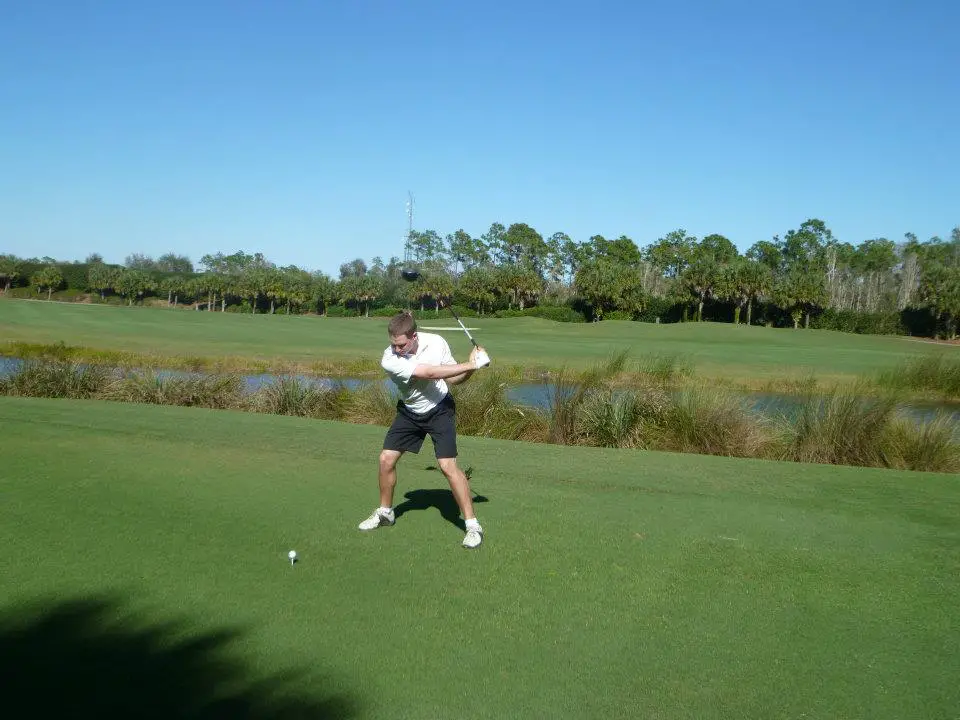
My senior year, my lumbar spine stiffened and my back muscles spasmed after an intense workout. It got so bad, I thought I’d miss the next tournament. And golf never hurt my back!
It was so stiff, I could only make 70% of a full golf swing. Icy-Hot patches helped me finish the tournament, and I actually played well. Maybe there’s truth to the “shorten your backswing” tip.
For treatment I went to the athletic trainers 2-3 days/week. In retrospect, the treatments likely prolonged my recovery.
First, I laid on my stomach with electrical stimulation pads on my back for about 15 minutes. This isn’t a recommended treatment for low back pain (1).
Next, the trainers stretched my back into flexion (forward-bending). Like most people with low back pain, lumbar flexion aggravates my low back (1). (I didn’t realize this at the time.) These stretches were counterproductive.
Last, I was strapped into a lumbar traction machine, which provides a gentle force to separate the lumbar vertebrae. Current guidelines say this treatment should not be used for patients like me, with low back pain without leg pain (1).
Even worse, the traction protocol used on my spine is for treating lumbar stenosis. Stenosis is common for adults in their 70s and 80s. College athletes, not so much.
Strike three.
My back pain eventually eased, in spite of the treatments.
Three unsuccessful rehab experiences drove me to learn how to manage my own back pain, and help others do the same. After college, I enrolled in physical therapy school. What better place to learn about back pain?
I learned about the McKenzie method of back pain treatment on my second clinical rotation. I read the McKenzie method guide for patients, called Treat Your Own Back. I tried the suggested stretches. They gave me instant relief. It was a game-changer!
Making a few small changes to how I sat and how I stretched gave me control over my back pain. I felt invincible! I could lift weights, golf, and play basketball without fear of injuring my back.
To be honest, my second PT (the one from church) taught me some of the same techniques. But they weren’t effective because I didn’t do the exercises or expect them to help. (Funny how that works.)
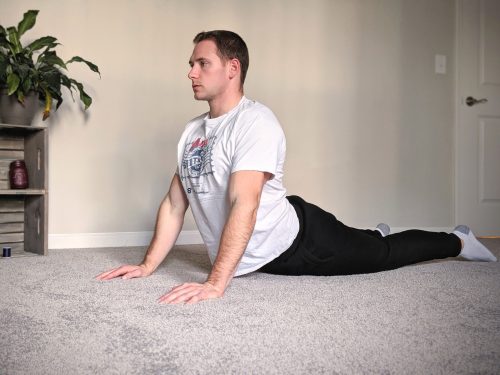
After I finished my Doctor of Physical Therapy degree, my wife and I relocated from Ohio to North Carolina. We wanted a change of scenery and couldn’t resist the warmer climate.
Early in my career I honed my skills at two outpatient PT clinics while earning my trigger point dry needling certification. Then in 2020 I completed a 1-year physical therapy residency program. PT residency programs are optional, advanced training programs with a specialization. (Mine was orthopedics.)
During the residency I learned how to apply research to help patients with various orthopedic issues. Many common treatments aren’t supported by science (which I experienced first-hand as a patient). But other proven treatments work great!
The advanced residency training helps me provide better care to patients in my current position. Right now I practice PT at a wellness facility where I treat patients ages 8 to 88+. I treat people with a variety of orthopedic issues–neck pain, low back pain and shoulder pain are the most common.
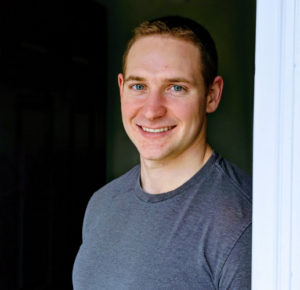
My wife and I enjoy powerlifting (bench press, squat, deadlift) and low back pain doesn’t keep me from doing heavy squats and deadlifts every week. I know exactly how to keep my back happy and what to do if it gets irritated.

My wife and I love hiking on the weekends and I still golf occasionally. Unlike a few years ago, I can now make a full, pain-free backswing!
I started this site to share my knowledge with you. So you don’t have to endure years of pain, frustration and unhelpful treatments like I did!
I look forward to helping you on your journey to better health!
For my best evidence-based health tips, join the free, fast-growing Facts & Physio Newsletter. Plus, get The Recovery Checklist when you sign up.

Download 7 Secrets to a Fast Recovery for free and join our weekly newsletter
No spam. Unsubscribe at any time.

I come from a competitive family. When we’re together, we meet physical activity guidelines like we suffer injuries – by accident. Backyard football games end
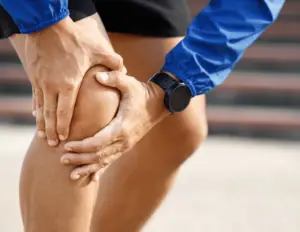
Knee osteoarthritis rehab is in high demand because knee arthritis is a massive problem. The average person has a 45% chance of getting painful knee osteoarthritis in
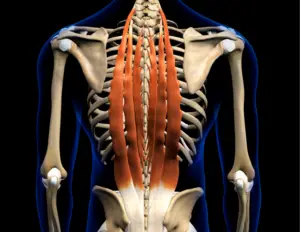
Regional interdependence explains how the body is like a toxic work environment; one dysfunctional member creates problems around it.

Does “no pain, no gain” work for injuries? How much should physical therapy hurt? Two Types of Physios Pain is a controversial topic in the

3 reasons the worst physical therapy treatments seem to work. And how terrible treatments fixed my pain.
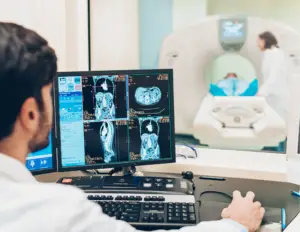
Last fall I drove through Hurricane Ian to attend a spine conference. Top spine surgeons and back pain specialists from the Southeast U.S. headlined the